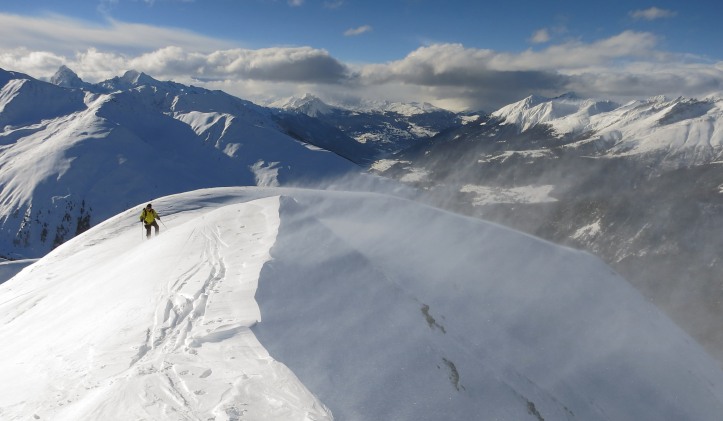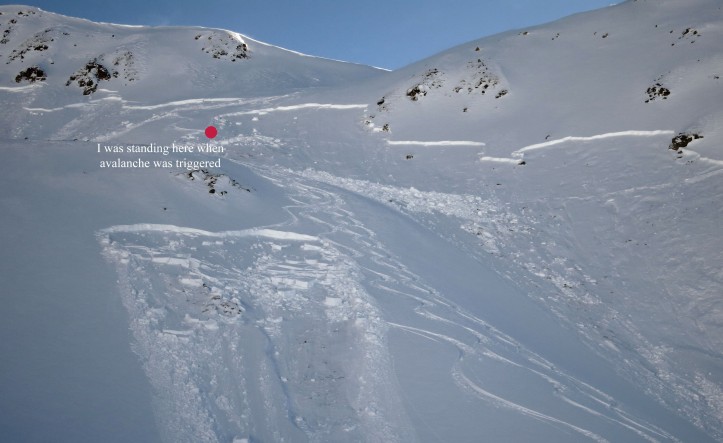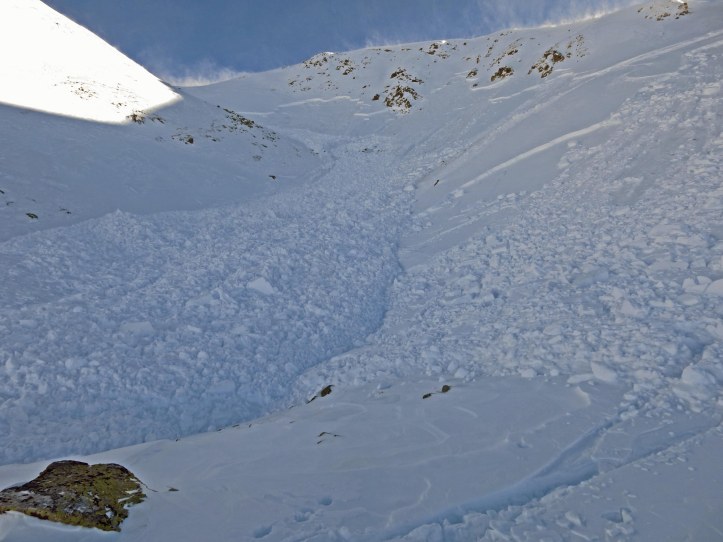While I am by no means an avalanche expert, I have had some experience with avalanches. I recently studied the various research and statistics, mostly published by the Swiss Institute for Snow and Avalanche Research SLF (www.slf.ch). Here are some conclusions which I thought are worthwhile sharing with you. There are about 15 -20 avalanche ski touring victims in the Swiss Alps per year (and another 5-10 offpiste casualties per year).
Also, check out the excellent webpage of Tirol/Italy Avalanche Center.
A further very useful information is the map of the avalanche deaths during the last 20 years, published by SLF here.
Wind-blown ridge of Erezberg (Davos) at Christmas 2013/14
(new snow and wind = avalanche danger)

Conclusions from Research & Statistics (and a bit from my own experience)
- Less snow ≠ less avalanche danger! (with little snow the snow cover is not compacted and can remain unstable over weeks, as we had it in early 2015).
- The average (deadly) avalanche is usually 50m to 100m wide!
This means that on the way up (in dangerous slopes) ski tourers in a group should be at least 50m apart (horizontally), better 100m. The often quoted 10m to 15m “safety distance” between persons might put less pressure on the snow pack, but is not enough to keep more than one person out of an avalanche, if there is one. - Make sure that there is not more then one person is in the “danger” zone!
Uphill see above. Downhill: Always (!) ski out of the danger zone, before the next skier is following. Rescuing one person is much easier than two or more. And remember that the avalanche is often triggered by the second or third skier. PS: According to the statistics, more avalanches are triggered on the downhill, but more persons are caught per avalanches going uphill. - 80% of deadly avalanches happen in bowls/gullies (“Mulden”), close to ridge tops (“Kammlagen”) and rocky terrain (“felsdurchsetztes Gelände”). In “Mulden” and “Kammlagen” an avalanche can be triggered especially at the border of little to more snow. Only 20% of deadly avalanches happen on “flat” or open slopes. The conclusion is that in steep slopes one should stay on the flat or convex part of the slope.
- Over 90% of avalanche accidents are with snow slabs (“Schneebretter”) and in dry snow conditions.
- Be aware of (or avoid) +30% slopes facing NW to NE (or even E) in moderate (“mässig”) or considerable (“erheblich”) avalanche danger. Most avalanches are triggered in that exposure. The steepest part of the slope is relevant!! If in doubt, enter the slope as low as possible. PS: Avalanches can (sometimes, but not often) also be triggered in slopes with less than 30%, but hardly ever in low or moderate avalanche conditions. Also, there have been deadly accidents even at low avalanche danger!
- The number of deadly avalanche deaths was lower in moderate danger situations (“mässig”) then in considerable danger situations (“erheblich”). But still deadly avalanches in moderate danger account for about 30% of all deaths. Note: In moderate danger, more ski tourers are on the slopes, of course.
- The avalanche risk is estimated to increase by about a factor of 3x from low to moderate danger, and another 2x from moderate to considerable danger.
- Slopes which have been skied (frequently) before the snow fall seem to be safer (85% of avalanche accidents were in slopes without tracks or tracks from the same day). Tracks from the same day are not a sign of less danger!
- Companion rescue provides by far the best chance for survival for completely buried avalanche victims. Do not forget to call for the victim (close to 10% of avalanche victims can be found that way).
- Group dynamics: There is some research, but no really convincing data on this subject. Here are some findings: Local knowledge and avalanche expert knowledge can lead to overconfidence. Well-trained ski tourers seem to be more careful in areas they do not know. Groups of ski tourers that go on tours regularly together seem to be a bit safer, than heterogenous groups. Going alone is generally not advisable.
- Areas such a Grison (Graubünden) or the Valais with a more continental or drier climate and/or less snow (and thus frequently with an unfavourable snow pack) seem to be a more dangerous than areas with lots of snow (such as e.g. Central Switzerland).
Read as many avalanche accident reports as possible!
Example: The SLF publishes reports on avalanche accidents etc.
The Riskiest Combinations
- New snow
- Wind
- North-facing slopes +35%
- Bowls or close to ridge tops
- Groups in these slopes
Avalanche Triggering Snow Patterns
Wind-blown snow (Triebschnee), old/weak snow (Altschnee) and wet snow (Nassschnee) are the most common mentioned avalanche triggering snow patterns. Lawinendienst Tirol has published a more sophisticated list of dangerous snow conditions (here). I have not seen much research or statistics in relation to snow patterns. However, 90% of avalanches triggered by ski tourers are dry/cold “slab avalanches” (Schneebretter) as opposed to wet avalanches.
Wind-blown snow pattern: Avalanche behind Erezberg (Davos) with a width of approx. 400m (I was lucky!
)
Some Recommendations by Stephen Harvey (from SLF) et al
Low avalanche danger:
Only one person in very steep slopes. Avoid snow drifts in the extreme steep slopes. Consider that an avalanche could lead to a fall over rocks etc.
Moderate avalanche danger:
Avoid very steep slopes that are mentioned as dangerous in the avalanche bulletin. Be cautious in +35% slopes in exposures mentioned by the avalanche bulletin. Make sure only one person skies in such slopes at a time. Chose your route carefully.
Considerable avalanche danger:
You need experience in avalanche judgement. Avoid all +35% (or better +30%) slopes in exposures mentioned by the avalanche bulletin plus all steep shadowy slopes.


Excellent summary. The most useful, easy to remember and to implement advice in my own experience : in doubt always ski the convex part of the slope !